U.S. Department of Transportation
Federal Highway Administration
1200 New Jersey Avenue, SE
Washington, DC 20590
202-366-4000
A greater use of mobile enforcement activities and few fixed roadside weigh facilities were consistently observed in the countries visited. This strategy results in a lower volume of trucks being processed and geographically and geometrically constrained inspection and offloading areas, but it provides more flexibility to respond to industry loading and routing patterns and more efficient and effective enforcement action.
Many European enforcement entities have dedicated personnel for size and weight enforcement. Often, size and weight enforcement personnel are not authorized to perform duties beyond size and weight enforcement (i.e., not authorized to stop vehicles, carry firearms, perform arrests). If an obvious safety, credential, or criminal problem is noted, personnel authorized to address these issues are called to assist. A high level of collaboration in commercial motor vehicle size and weight enforcement activities was observed in several of the countries visited between similar agencies of different jurisdictional levels (e.g., national and regional law enforcement agencies) and between different agencies (e.g., transportation and law enforcement agencies). It was also observed that private sector entities work closely with government and research bodies to refine and enhance product performance and accuracy.
Citation issuance procedures and fine amounts differed between and within the countries visited, varying by the assumed violator (i.e., driver, carrier, or both), unique procedures for foreign drivers and carriers, and the time allowed for establishing and responding to the fine (in many instance, the fine was immediate). In general, the citation amounts were reported to be sufficient as a deterrent.
In the countries visited, WIM technology is used predominately to support commercial vehicle size and weight enforcement through:
Slovenia uses several roving enforcement vehicles operated by the Traffic Enforcement Section, under the Uniformed Police Directorate of the Ministry of the Interior, to provide commercial motor vehicle size and weight enforcement. The country has no fixed weigh facilities. In addition to size and weight measuring capabilities, the vehicles have equipment to check emissions, perform a full safety check, and communicate with the central office for credential checks (see figures 20 and 21). These vehicles patrol the motorways and, when appropriate, the secondary roads, targeting areas where violations are observed or suspected. The Traffic Enforcement Section is supported by CESTEL personnel who install, maintain, and process data for the bridge WIM systems.
Figure 20: Slovenia: mobile enforcement vehicle.
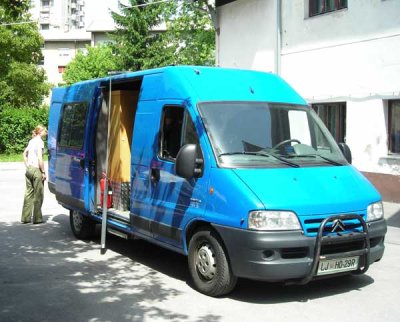
Figure 21: Slovenia: mobile enforcement vehicle.
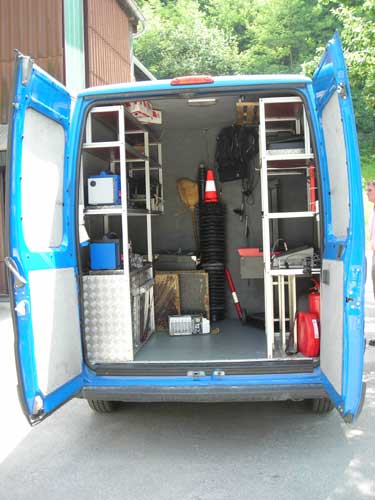
In recent years, these roving enforcement vehicles have integrated technology, including bridge WIM systems (SiWIM), into their operations in two ways:
Preselection. To preselect an overloaded vehicle from the traffic stream, the SiWIM systems are used in conjunction with a video camera and a handheld or portable computer capable of receiving both the weight data and the vehicle image. Vehicle information—including vehicle class, gross weight, axle loads, overloading status, time of arrival, lane, and speed—and a video image of the vehicle allow enforcement officers to escort suspected noncompliant vehicles off the main roadway to the mobile enforcement site for static weighing and additional inspection (see figures 22 and 23). This preselection method reportedly results in high efficiencies; more than 80 percent of vehicles preselected for inspection by the SiWIM system are confirmed as overweight and are ticketed. The SiWIM system is used only as a prescreening tool to select vehicles for further inspection and evaluation. No citations are directly issued using SiWIM system data.
Figure 22: Slovenia: mobile enforcement.
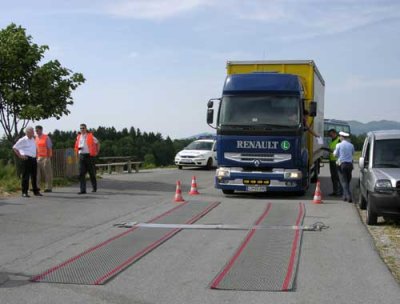
Figure 23: Slovenia: mobile enforcement.
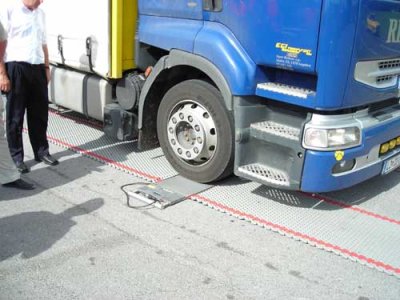
Scheduling of enforcement activities. To support scheduling of mobile enforcement patrols, historical SiWIM data are used. Mobile enforcement units, working closely with the Directorate of the Republic of Slovenia for Roads and Cestel (for SiWIM system data analysis and installations), determine a location and time for enforcement one month in advance. Three groups, composed of enforcement and Cestel personnel, are at different locations each day, controlling the main roads and the borders. Well-informed truck drivers limit the amount of time that can be effectively spent at each mobile enforcement site. Nonetheless, these three teams controlled more than 6,200 trucks in 2005. Fifty-six percent of captured trucks were overloaded in 2005, up from 18 percent in 1998.
Particular industries in Slovenia, such as quarries, gravel pits, and construction areas, pose special problems and need to be enforced more often. At one observed site, 73.9 percent of overweight vehicles were attributable to these. Slovenian officials reported that the low fines for overloaded travel are relatively ineffective deterrents and recommend the use of SiWIM data to support development of an inversely exponentially increasing fine structure ranging from €200 to €3,000 for gross offenders. SiWIM data suggest that the majority of vehicles (nearly 60 percent) modestly exceed (by less than 10 percent) axle load limits. About 5 percent of the vehicles, however, exceed axle load limits by more than 40 percent.
Several formal sets of guidelines support traditional commercial vehicle size and weight enforcement:
Directives on the recently implemented vehicle profile measurement devices are under development.
Preselection. More informally, relying on the performance achieved by piezoquartz sensors and multiple-sensor arrays to further enhance accuracy, the Swiss have developed an enforcement strategy for remote Alpine region tunnels.(15,16) The system consists of multiple quartz-based WIM sensors, infrared height detectors, video cameras, and variable traffic signals for adaptive control. Weight, height, and video data are transmitted to a central traffic control center, enabling identification of overloaded or excessive height vehicles. These data are simultaneously transferred to the next police enforcement site downstream, equipped with a weighing system certified for enforcement.
A similar process is followed at routine enforcement locations. Swiss cantonal police use WIM systems for preselection along the main roadways. If suspected as overweight, a vehicle is escorted by police to an offsite but nearby fixed weigh facility where it is statically weighed and measured either manually or with a vehicle profiler system (see figure 24). If a vehicle is confirmed to be overweight or oversize, the driver and/or company is issued a citation accordingly or required to offload the vehicle before proceeding.
Figure 24: Switzerland: fixed weight/size facility.
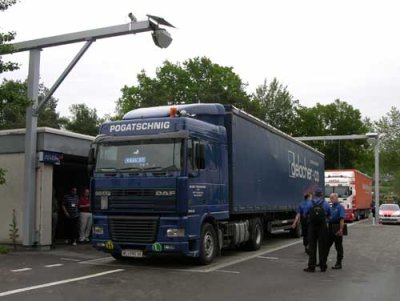
The use of WIM for preselection is reported to increase Swiss cantonal police enforcement effectiveness and efficiency for commercial motor vehicle size and weight. The Swiss do not define specific numeric metrics to ensure that a sufficient number of vehicle checks are conducted. As police continue to spread their time over many activities, truck weight enforcement will continue to decline in importance. For this reason, the Swiss would like to see the use of technology for this application increase.
Preselection. For day-to-day operations, Germany uses a system of about 40 WIM sites that support mobile enforcement efforts, as well as statistical data gathering. The WIM sites commonly use sensors in the right lane or right two lanes only with traffic sensors (i.e., electronic loops) installed across all lanes. This layout plan significantly reduces capital installation costs while still capturing weight data for an estimated 80 percent of the heavy traffic.
As part of the Toll Collect system, the German autobahn system has 300 "toll checker" gantries strategically located throughout the country and equipped with IR detection equipment and high-resolution cameras able to profile trucks and record number plates. These gantries do not include any weight capture capabilities (e.g., WIM), but are capable of prescreening for potentially oversized vehicles.
In addition to the gantries, Toll Collect also relies on specially assigned mobile patrols consisting of a fleet of 300 vehicles with 540 officers from the German Federal Office for Transport of Goods (BAG) (see figure 25). Video and license plate information captured at the gantries can be sent to downstream mobile enforcement units. The officers patrol the autobahns, checking vehicles and drivers to see if they have paid the toll or have onboard units (OBUs) installed (these enforcement vehicles are equipped with infrared dedicated short-range communications (DSRC) systems that can be used to scan and monitor trucks in motion).
Figure 25: Germany: mobile enforcement vehicle for Toll Collect system.
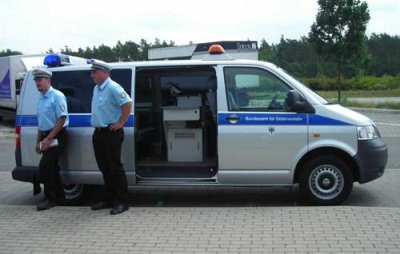
While BAG officers have police powers to request trucks to stop for examination any time during their journey, they are not authorized to conduct size or weight enforcement. If a truck is stopped for a toll violation and an oversize or overweight violation is suspected, alternative mobile police units must be dispatched for enforcement of size and weight. These alternative mobile police units similarly do not have authority to enforce tolling. Political motivations separated toll enforcement from regular police forces. As reported by German officials, enforcement efforts are not well coordinated. A vehicle driver may experience a special or classical (full) control by enforcement officials and toll control within a few kilometers.
In the Netherlands, the National Police Agency (KLPD), the Inspectorate of Transport, Public Works, and Water Management (Transport Inspectorate), the Public Prosecution Service, and the Ministry of Transport, Public Works, and Water Management (Ministry of Transport) are partners in enforcing commercial motor vehicle size and weight regulations. To ensure that commercial motor vehicle size and weight enforcement is a continued priority, particularly among police agencies, the Ministry of Transport funds additional police officers who focus about 40 percent of their time on weight enforcement and 60 percent on anticongestion and incident-management activities. This special project detail has about 100 officers who are trained in 80 percent of full police officer duties. They do not carry firearms or drive motorcycles, which require a special permit. These officers are always paired with a fully trained police officer for safety, which increases the overall cost of the program. The Transport Inspectorate is an independent inspection entity of the Dutch Ministry of Transport tasked with promoting safety in transport. Inspectorate personnel can perform commercial vehicle size and weight enforcement duties, but are also tasked with monitoring and enforcing regulations on vehicle insurance, fleet maintenance, vehicle safety, and environmental conditions. This partnership supports commercial motor vehicle enforcement activities related to:
Preselection. In the late 1990s the Dutch developed an innovative WIM and video system (WIM/VID) at a test site on the highway between Antwerp and Rotterdam to support preselection of overweight vehicles from the traffic stream.(27) Technologies and procedures developed at the initial WIM/VID test site have been integrated into routine commercial motor vehicle size and weight enforcement activities. Each WIM/VID site is equipped with piezoquartz WIM sensors in the right two lanes, two cameras on each side of the road to capture the vehicle image, and cameras above each lane to capture license plates. Electronic loops and cameras in the third lane and right shoulder detect bypassing vehicles. Enforcement officers from the National Police Agency use laptops in their mobile units to receive information (data and video) from the upstream WIM site (see figures 26, 27, and 28). Overweight determination is processed within 15 seconds. The officer at the mobile enforcement site contacts onroad colleagues to intercept the overloaded vehicle and escort it for further inspection and evaluation. At the mobile enforcement site, static axle loads are captured (see figure 29). Modest checks for registration and safety are also conducted as part of the weight enforcement effort.
Figure 26: The Netherlands: mobile enforcement.
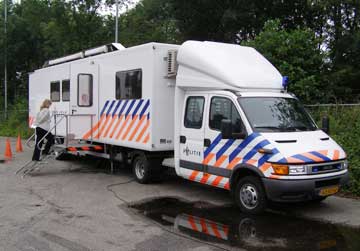
Figure 27: The Netherlands: mobile enforcement.
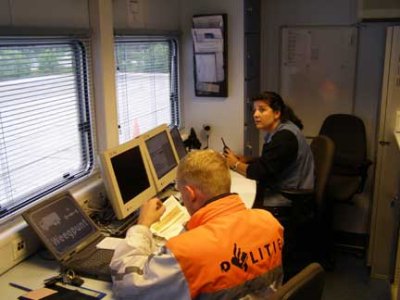
Figure 28: The Netherlands: mobile enforcement.
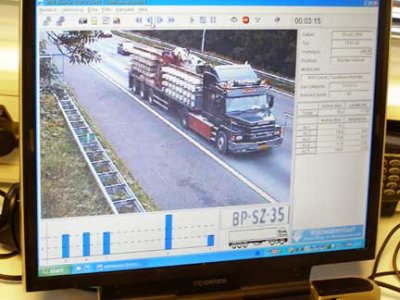
Figure 29: The Netherlands: mobile enforcement.
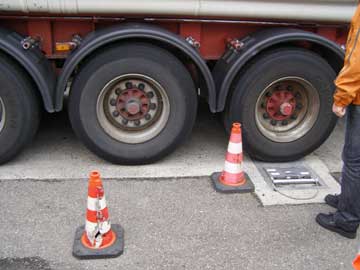
If a vehicle is confirmed to be overweight, the appropriate citation is issued to the company.
If the fine goes unpaid, the company owner is required to appear before the prosecutor. Enforcement officials try to balance enforcement activities with the prosecution system. If enforcement officials are highly productive but the prosecution system is not, the effort may be wasted. Revenue from commercial motor vehicle size and weight enforcement efforts is deposited in the general government budget.
This preselection process has been credited with increasing officer efficiency (i.e., the number of citations issued compared to the number of vehicles stopped) from about 40 percent to more than 80 percent. The trucking industry is reacting to these preselection controls by using bypass routes or, more positively, by investing in new vehicle configurations (e.g., with additional lightweight axles) and in-vehicle weighing systems to better self-monitor loading behavior. These actions are limited, however, since outside of the six enforcement control points, the odds of being detected when traveling overweight are minimal.
Scheduling enforcement activities. In addition to using technology to support preselection activities, the Dutch use historical WIM data to support the scheduling of the time and location (to the extent possible) of enforcement activities. Using the most recent week and the past 6 weeks of WIM data, the time of day, day of the week, and location of high overweight vehicle activity are determined. For example, just before the morning rush hour (i.e., 5 to 7 a.m.) is commonly the worst period for overloading at one site in the Netherlands. In the near future, the enforcement activities of the National Police and the Transport Inspectorate will be coordinated. National Police officers will focus on the highway network (at preselection sites) and the Inspectorate officers will focus on the secondary road network with particular focus on bypass routes for the preselection sites.
Directing preventive company contacts. While officials from both the Dutch National Police Agency and the Transport Inspectorate have the authority to conduct roadside commercial motor vehicle size and weight enforcement, the advent of the WIM/VID systems has allowed the Transport Inspectorate to shift its focus from performing roadside inspections to conducting carrier/company advisory notices of noncompliance and/or preventive visits. In the Transport Inspectorate's view, preventive company contacts are more efficient than roadside inspections because a single contact can reach companywide rather than a single driver. In addition, application of the WIM/VID system for company contacts allows for 100 percent capture and review of overloads (i.e., 24-hour-a-day, 7-day-a-week monitoring). Roadside inspections are effective only when enforcement officials are present.
The general process is as follows:
The company contact procedure is only effective for Dutch companies. No mechanism exists to conduct preventive contacts with foreign companies. The program is well received by industry, although noncompliant companies are less receptive as the latter phases of the process are implemented.
The Walloon Region is the only one in Belgium actively deploying WIM systems, with six piezoceramic WIM systems in operation. These systems are used predominantly to collect data for statistical planning purposes, not enforcement. The Belgian Federal Police Services recognize the potential for benefit from the use of WIM systems for preselection and hope to move toward this application. A test site modeled after the WIM/VID systems in the Netherlands is under development in the Flemish Region.
Under current operations, enforcement officials, from the Federal Police Services to the regional road administrations, rely only on fixed and mobile enforcement, using shared public or private static weigh bridges or low-speed WIM systems. Enforcement officials allow vehicles to roll at very low speeds (less than 5 km/h) over the WIM systems for weight capture using load cell technology. Vehicles carrying liquids or shifting loads are required to come to a complete stop on the scales for accurate measurement. A 3 percent tolerance is allowed for citation issuance.
Currently, a citation is issued to the driver, although pending regulations will allow both the driver and the company to be cited. Fines range from €55 to €55,000. Enforcement officers cannot collect the fee at the enforcement site, except in the case of foreign vehicles. A prosecutor must determine the fine amount for noncompliant domestic vehicles. Grossly overloaded vehicles (more than 20 percent overloaded) can be required to be fully unloaded to allow the vehicle to undergo a complete inspection of brakes, suspension, etc. The driver may also go to jail.
Unlike the countries visited that have specially trained personnel dedicated primarily to commercial motor vehicle size and weight enforcement, the Belgian Federal Police Services perform a more complete inspection for every vehicle stopped, checking driving and resting hours, vehicle tachograph readings, criminal use, etc. Priorities for enforcement in Belgium include driving and resting time, in-between distance, and weight. Vehicle size limits are not usually checked unless a recognized problem exists.
Similar to the Netherlands, technology is being used to broadly support commercial vehicle size and weight enforcement through:
Preselection. France has two prototype VIDEO-WIM systems, with plans for expanded implementation at 10 to 40 sites. Using these systems, a picture of a suspected overloaded vehicle (as determined by the WIM sensors) is immediately transmitted by radio waves or telephone lines to enforcement officials (either transport inspectors from the Ministry of Transportation or police officers from the Ministry of Police) at a static weighing area (see figure 30). Once identified, enforcement officials escort the vehicle to the static site for further inspection and evaluation (see figure 31). Vehicles that are confirmed to be overloaded using the static scales are fined accordingly. The prescreening system is set to flag (i.e., image is captured and a record is made) every vehicle suspected as over legal limits. The enforcement officer still uses discretion to determine whether to pull the vehicle in, based on the available storage space of the facility, knowledge of the company, etc.
Figure 30: France: mobile enforcement.

Figure 31: France: mobile enforcement.
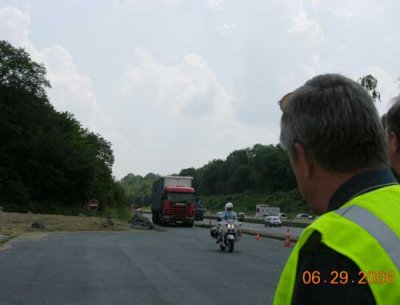
Static weighing can be accomplished at any of the country's fixed static enforcement sites, located most commonly near toll areas and along national roads. In addition, 219 mobile enforcement units (vans, light vans, etc.) can set up temporary sites for static weighing wherever sufficient space exists using portable static scales. Mobile enforcement requires a space 30 meters long with nearby parking lots or rest areas for vehicle storage (see figure 32).
Figure 32: France: mobile enforcement.
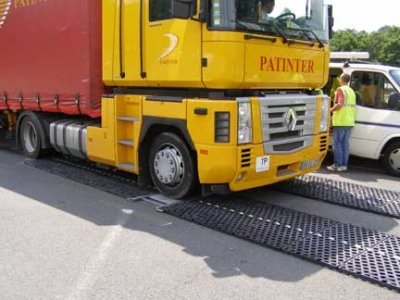
The use of low-speed WIM systems in place of static scales for citation issuance was recently approved in France, allowing up to 10 times more vehicles to be processed. Following extensive testing to prove system acceptability, enforcement officials received approval from the National Metrological Organization and the two first systems are being installed along the RN4 at Rupt-aux-Nonains and nearby Châlon-sur-Saône.
Directing preventive company contacts. In addition to using the two prototype VIDEO-WIM systems to support preselection activities, the French use them to direct carrier/company advisory notices of noncompliance and preventive visits. Using data from the prototype WIM systems, enforcement officials can determine common offending vehicles and their companies. WIM sensors provide the weight-related information and the video image of the license plate/truck provides the company identifier. Warning letters are issued regularly to the top 10 offending companies. While no citation is issued based on the WIM system data, companies are made aware that their loading behavior is being monitored. France has initiated a 3-year study to determine the effect of these preventive company contacts on loading behavior.
Scheduling enforcement activities. The French also use historical WIM data to support the scheduling of the time and location (to the extent possible) of enforcement activities, relying not only on the two prototype sites, but also on the full network of 170 WIM systems. Overweight commercial motor vehicle characteristics are summarized and reported to police officials through SIREDO by month, day of the week, and hour of the day to support scheduling of mobile enforcement efforts.
Fully automated commercial motor vehicle size and weight enforcement using high-speed WIM is estimated to be 5 to 20 years in the future, according to officials in France and the Netherlands, the emergent leaders in automating enforcement efforts. Primary challenges for high-speed WIM applications include:
In addition, the complexity of high-speed WIM system technology requires development of new test procedures for certification.
France (as well as Germany and the United Kingdom) has obtained approval from the national metrology authority to certify low-speed WIM for use in enforcement. Belgium is also using low-speed WIM systems for direct enforcement, although it is unclear what legal or metrological changes were required to support this practice. Low-speed WIM systems differ from high-speed systems in technology, certification, and application. The test procedure required for certification of a low-speed WIM system is similar to that of a static weigh system, making it relatively simple for and familiar to the National Metrology Institute.
Slovenia's legislature does not yet allow use of WIM data for direct enforcement of overloaded vehicles. The Swiss report concerns about high standard deviations for accuracy from high-speed WIM systems that would require sizable tolerances for enforcement. According to the Swiss, high tolerances in size and weight limits would not act as a sufficient deterrent for ensuring compliant commercial vehicle behavior. The Germans cited the costs associated with multiple-sensor WIM, continued challenges with reliability, and remaining legal roadblocks as reasons for not pursuing automated enforcement of commercial motor vehicle size and weight. Further, if a truck is detected as overweight or overloaded, facilities are still required downstream from the automated enforcement site to allow for offloading or other action.
Despite these shortcomings, the use of high-speed WIM systems for automated commercial motor vehicle enforcement would greatly increase the number of vehicles monitored (i.e., to 100 percent along an instrumented route), the proportion of overloaded vehicles detected in the traffic stream, and the number of overloaded vehicles appropriately cited. High-speed WIM systems also support identification of habitual noncompliant carriers for whom compliance can be further encouraged through preventive company contacts. If a grossly overloaded vehicle (i.e., requiring offloading) is detected, manual enforcement action is still required. If manual enforcement methods were used exclusively in this instance, the vehicle may have gone undetected unless active patrols were in place along the route and officers were already checking other vehicles, or if officers did not perceive the vehicle to be overloaded.
The success of the WIM/VID system for improved targeting of overloaded vehicles motivated the initiation of the Overbelading (Overloading) Project, consisting of a number of smaller projects. One of these projects, WIM-HAND, sought to achieve true automated enforcement of overloaded vehicles. WIM/VID enhanced targeting of overloaded vehicles, but required static weighing for citation issuance. Automatic enforcement means that when the WIM system detects an overloaded vehicle (or axle), prosecution of the vehicle owner is directly based on the measured axle loads combined with the recorded video images of the vehicle (including the license plate).(28)
The WIM-HAND Project focused only on the technical measurement process. Data processing or integration of the systems into the operational process of the enforcing authorities was not part of this project. However, preparation of the metrological certification for the developed measuring system for use in direct enforcement was considered part of the project's scope.
At the onset of the WIM-HAND Project, the following WIM system general minimum accuracy requirements for automated enforcement were defined:
A WIM system with an inaccuracy of less than 10 percent and a degree of certainty of more than 99 percent is deemed feasible from a technical viewpoint and deemed employable for use in automatic enforcement.
To achieve these accuracy levels, researchers focused on the development of a multiple-sensor WIM system using piezoquartz sensor technology at a single test site along the northern carriageway of the A12/A50 highway near Arnhem. For such a system, determining the proper layout of the sensor array is essential. The objective is to maximize accuracy and reliability while minimizing the number of sensors used. In this case, the number of sensors was limited by the available budget, so 16 rows of WIM sensors were used. Because the WIM system was used for research and not enforcement, the system was installed in the right lane only.
The test site was divided over three locations:
During the WIM-HAND Project, unfortunately, initial problems with the WIM sensors precluded any practical tests of the system. Hence, the study objective shifted to focus on national and international acceptance of WIM for direct enforcement of commercial motor vehicle size and weight. According to the Dutch, before WIM systems can be used for automatic enforcement of overloading, the following technical and nontechnical issues must be addressed:
The calibration, testing, and processing of measurement results from the WIM-HAND test site are being investigated in a follow-up project, WIM-HAND2.
Historically, France has focused on achieving automation in commercial motor vehicle size and weight enforcement. These efforts have been challenged by the ability to define required accuracy levels to provide defensibility in court and determine the legal weight for a vehicle. Factors other than axle configuration are used to determine the allowable load on a vehicle (e.g., the French have three different legal gross vehicle weights (GVWs) for a two-axle truck).
Recently, France established an automatic overloading control test site to advance the use of WIM systems for automated enforcement.(29) The site, located along the RN4 between Nancy and Paris, will bring together video-based preselection systems, multiple-sensor WIM systems, and low-speed WIM systems. The preselection system will be modeled after the two prototype systems described previously along RN83 and A31. The multiple-sensor WIM system will consist of a 16 piezoceramic sensor array, two wheel transverse location detection systems (to account for wheels passing too closely to the WIM sensor edge and to apply correction factors due to the transverse sensitivity of the sensors), and a temperature sensor. The low-speed WIM system, to be installed at a newly constructed rest area, will be used for direct enforcement (France has recently received approval for legal metrology of low-speed WIM). Variable message signs (VMS) and bicolored (red and green) lights will direct approaching and onsite drivers, depending on their status (i.e., suspected overloaded, confirmed overloaded). A video camera with license plate recognition capabilities would allow complete automated enforcement.
The certification of low-speed WIM systems for direct enforcement by the National Metrology Institute represents a significant advancement toward automated enforcement in France. Until now, the metrological community was unwilling to recognize dynamically captured measurements as true measurements. The use of low-speed WIM will allow enforcement officers to process up to 10 times more vehicles, even with vehicle speeds constrained to 10 km/h, greatly enhancing the efficiency of commercial motor vehicle weight enforcement.
In many of the countries visited, bypass of enforcement activities was discussed as a concern. Mobile enforcement activities, by their nature, are generally able to address any bypass-related challenges. As the Swiss continue to expand their permanent enforcement centers on the motorways, one future operational strategy may be to use mobile enforcement on secondary parallel routes. Both France and the Netherlands have integrated bypass considerations as part of their WIM site selection process, locating WIM systems to discourage obvious or convenient bypass (e.g., near river crossings or mountain passes).
Unique procedures for addressing OS/OW permitting in the countries visited focused on:
Ensuring that intended legally permitted OS/OW vehicles are in fact legal poses a bigger challenge. In the Netherlands, it is estimated that 40 percent of special transport (e.g., OS/OW) trucks do not operate with proper credentials. Officials opted for the public relations approach (e.g., company profiling and educational contacts) rather than the enforcement approach to educate this sector of the industry. Slovenia experiences similar challenges with special transport vehicles. When observed in the field, more than 70 percent of special transports had at least one violation. When observed before transport, more than 50 percent had at least one violation. Of these movements, 47 percent of special transports were found to be overweight. The remaining percent had permit issuance or other violations.
Benefits from the technologies or procedures used were largely anecdotal, and only limited quantified benefits were provided. Anecdotal benefits related to increased enforcement efficiency through the use of technology (i.e., providing greater enforcement effort with fewer human resources) were provided by Swiss, Dutch, and French representatives. The most common quantified benefit reported related to onsite enforcement efficiency—the number of overweight penalties issued (i.e., warning, citation) per total number of trucks inspected.
In Slovenia, an analysis of WIM data conducted in 2003 revealed that current static weight enforcement methods capture less than 0.5 percent of all overloaded vehicles (www.siwim.com). With appropriate WIM system tolerances, the sum of overloading fines could exceed €300 million, which is about 30 times more than is collected now from static weight controls. These findings, combined with reported enhancements to enforcement efficiency, suggest significant benefits from WIM systems for preselection applications.
A greater use of mobile enforcement activities and few fixed roadside weigh facilities were consistently observed in the countries visited. This strategy results in a lower volume of trucks being processed and geographically and geometrically constrained inspection and offloading areas, but it provides more flexibility to respond to industry loading and routing patterns. The United States, on the other hand, relies heavily on its network of fixed facilities and less on mobile enforcement activities, although the trend is moving toward a greater use of mobile enforcement.
As in the United States, WIM system technology is commonly used in the European countries visited for real-time preselection of overloaded vehicles from the traffic stream for enforcement. In addition, many of the countries use WIM systems to:
This latter application mimics the compliance reviews performed by the Federal Motor Carrier Safety Administration in the United States to enhance motor carrier safety through prevention. The use of WIM data for enforcement scheduling applications varies throughout the United States.
In many of the countries visited, bypass of enforcement activities was discussed as a concern. Mobile enforcement activities, by their nature, are generally able to address any bypass-related challenges. Hence, the countries visited may be better positioned to address bypass than the United States with its network of fixed facilities.
Unique procedures for addressing OS/OW permitting in the countries visited focused on:
In the United States, some States have developed similar routing Web sites with a focus on intrastate travel.
The primary performance metric related to commercial motor vehicle size and weight enforcement was enforcement efficiency—the number of overweight penalties issued per total number of trucks inspected. It was not uncommon to have efficiencies of more than 80 percent with WIM systems used for preselection. In the United States, the fixed-scale facilities are able to process a high volume of trucks, but few are found to be in violation (limitations to U.S. fixed-scale enforcement efficiencies include restricted hours of operation, bypassing, and storage limitations at the facility). The Netherlands is focused on achieving aggregate overload reductions through both prevention and enforcement measures.
| << Previous | Contents | Next >> |